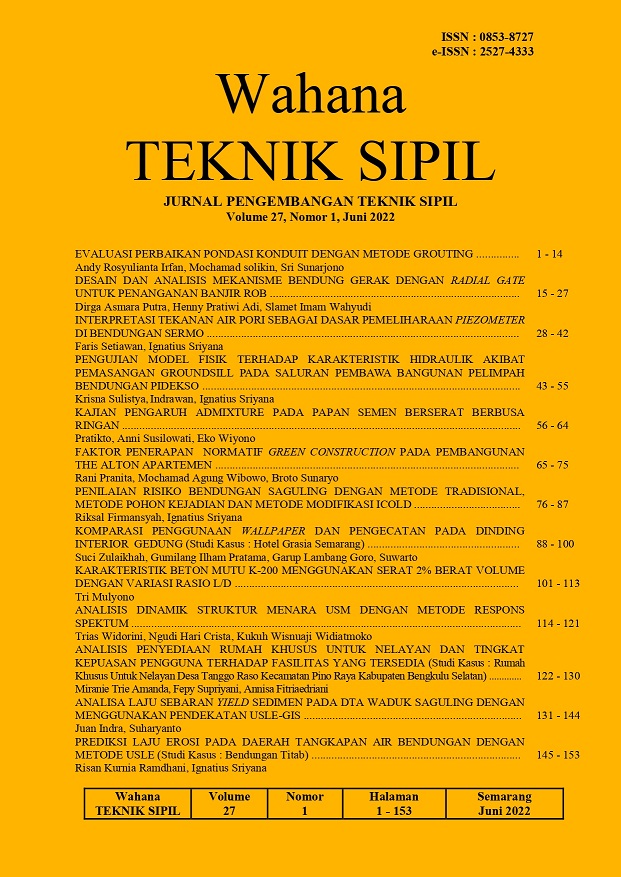PENILAIAN RISIKO BENDUNGAN SAGULING DENGAN METODE TRADISIONAL, METODE POHON KEJADIAN DAN METODE MODIFIKASI ICOLD
DOI:
https://doi.org/10.32497/wahanats.v27i1.3673Keywords:
saguling dam, risk assessment, traditional method, event tree method, ICOLD methodAbstract
The role of dam infrastructure must be ensured from management and maintenance through good operational and maintenance provisions as to maintain level of service provision, extend life of productive assets and reduce risk of dam failure. Dam risk assessment can be used to prioritize dams based on risks. Risk assessment consists of risk analysis and risk evaluation. Purpose of this study is to conduct a risk assessment on Saguling Dam using traditional methods, event tree methods and ICOLD modification method to get an overview safety condition Saguling Dam. In conducting risk evaluation for ICOLD modification method, evaluate by comparing value of risk index to risk class. results of the risk identification analysis of this study that risk assessment using traditional method shows that risk of the Saguling Dam is unacceptable because this method does not describe each possibility in detail. Risk assessment using the event tree method shows that the risk of the Saguling Dam is acceptable. Risk assessment using the modified ICOLD method shows that the Saguling Dam belongs to category of Dam with moderate risk.References
Andersen, G.R., Chouinard, L.E., Hover, W.H., & Cox, C.W., 2001, Risk Indexing Tool to Assist in Prioritizing Improvements to Embankment Dam Inventories. Journal of Geotechnical and Geoenvironmental Engineering. 127(4), 325-334.
BBWS Citarum, 2020, Pembuatan Pola Operasi Waduk Kaskade Citarum. DOISP2.
Bank Dunia, 2018, “Meningkatkan Keamanan Bendungan dan Perlindungan Masyarakat Umum melalui Rencana Tindak Darurat dan Rencana Kontinjensi Berbasis Inasafe”, The World Bank Group. Washington, USA.
Brown, Alan., and Gosden, John, 2004, Risk Assessment of Dams ”“ recent developments in the United Kingdom.
Buldan, R., Suharyanto, & Sriyana, 2021, Penilaian risiko kegagalan bendungan kedungombo sebagai dasar prioritas pemeliharaan bendungan. Jurnal Mitra Teknik Sipil, 4(3), 557”“570.
Departemen PU, 1995, Bendungan Besar di Indonesia. Jakarta: Yayasan Badan Penerbit PU.
Ditjen SDA, 2011, Pedoman Teknis Penilaian Risiko.
Indrawan, D., 2013, Penilaian Indeks Risiko Metode Modifikasi Andersen Dan Modifikasi ICOLD Untuk 12 Bendungan Di Pulau Jawa. Jurnal Sumber Daya Air. 9(2), 93”“102.
Kementerian PUPR, 2015, Peraturan Menteri PUPR No.27/PRT/M/ 2015 tentang Bendungan. Kementerian PUPR.
Pramudawati, M.A.H., Mahdi I.T., & Ranisa, G., 2020, Penilaian Risiko Keamanan Bendungan Di Jawa Timur. Jurnal Teknik Hidraulik, 11(2), 93”“102.
Puslitbang Sumber Daya Air, 2006, Tingkat Keamanan Bendungan di Jawa. Volume II, Jawa Tengah. Bandung, Kementerian PUPR.
Soentoro, E.A., Purnomo, A.B., & Susantin, S.H., 2013, Study on Dam Risk Assessment as a Decision-Making Tool to Assist Prioritizing Maintenance of Embankment Dam in Indonesia. November.
Downloads
Published
Issue
Section
License
Authors who publish with this journal agree to the following terms:Authors retain copyright and grant the journal right of first publication with the work simultaneously licensed under a Creative Commons Attribution License that allows others to share the work with an acknowledgement of the work's authorship and initial publication in this journal.
Authors are able to enter into separate, additional contractual arrangements for the non-exclusive distribution of the journal's published version of the work (e.g., post it to an institutional repository or publish it in a book), with an acknowledgement of its initial publication in this journal.
Authors are permitted and encouraged to post their work online (e.g., in institutional repositories or on their website) prior to and during the submission process, as it can lead to productive exchanges, as well as earlier and greater citation of published work (See The Effect of Open Access).






